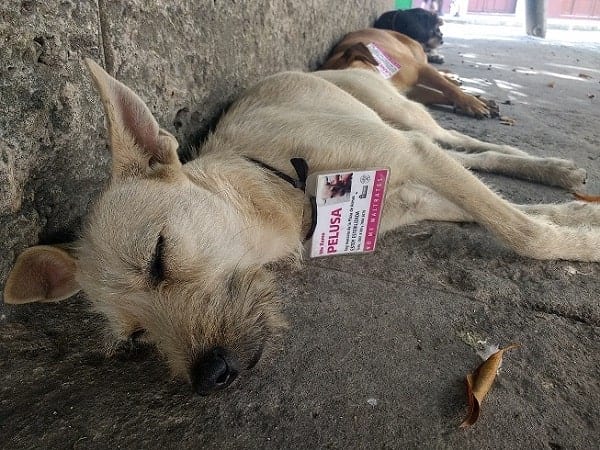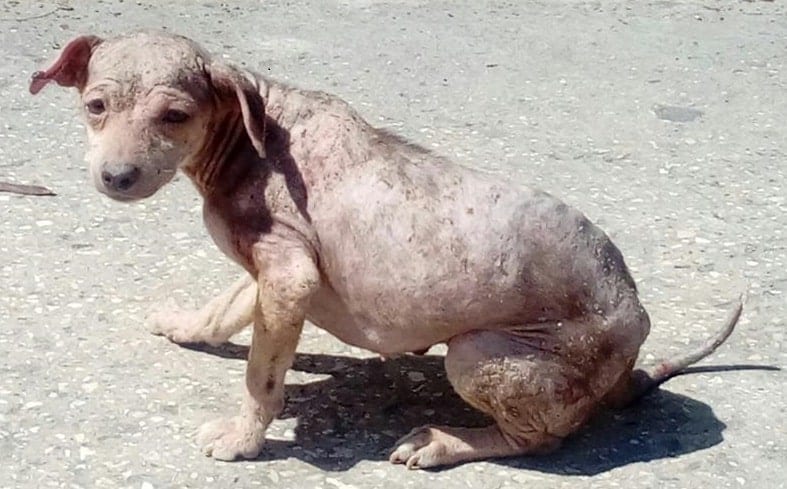Black Market Chemotherapy and Animal Sacrifices in Havana
The endless job saving dogs and cats on the streets of Havana
By Frances Thompson

HAVANA TIMES – It’s 9 pm and I am on the street, pacing up and down, holding a dog. His name will be Percy but neither of us know it yet. He’s gravely sick with distemper virus and in a comatose state, mucous dripping from his eyes and nose. I had noticed him in Havana’s most picturesque park where tour guides, horse carts and street dogs jostle for the attention of tourists.
Percy was clearly unwell, and I had decided to take him to the Carlos III veterinary hospital with a friend. We had wrapped him in a cement bag and taken him by bicycle rickshaw, where he was diagnosed with distemper and given a 50-50 chance. I was told that I must take him back to my home where he could be carefully nursed or he would not make it.
It wasn’t a straightforward decision. I was thinking that if he didn’t die of distemper, he would succumb to heat exhaustion on my balcony, in the direct rays of the afternoon sun. Besides, my small apartment was already ‘full’. There was a kitten who I had taken in, along with his brother, the day before Hurricane Irma.
Furthermore, my biggest fear besides death was that if the dog survived, I would end up keeping him; history repeating itself, since I had rescued a starving puppy only ten months earlier, while living in Sierra Leone, and had kept her since I couldn’t find a reliable owner.
Not ideal with my singleton lifestyle, which includes four months of annual travel, weekends away, weekdays at work and evenings out. Besides, I’m not old enough to be responsible for two dogs, I thought; I’m only 34.So there I was, alone at night on the streets of Havana with a sick dog, contemplating what I should do.
I made my decision. I placed the nameless dog where I had found him, in a flower bed in Parque Central, and arranged for the kitten to leave for his new home earlier than planned. The next day, I collected the dog and brought him home.
The other passengers in the 1950s Chevrolet now serving as a collective taxi didn’t seem to mind until his nose started dripping on them. His treatment which had included intravenous antibiotics, consultations and injections had come to 50 Cuban Pesos ($2 USD). This isn’t my job; I have a regular job. I just feel compelled to help because I can. Like most people, I have a choice to walk past suffering or to intervene. I choose to intervene.

That evening, I called my friend, Milene, herself living in a small studio with several rescued animals. I asked her what I should do if the dog died. She told me that I would have to place him in the garbage. The image stuck in my mind, as I lay awake all night, imagining what I was likely going to have to do before work that morning.
Well, the little black dog survived. His name, Percy, is short for ‘perseverance’. And Percy is mine. I searched but I could not find anyone that I could trust to give him everything he would need for his entire life. History has repeated itself.
There are dozens, or hundreds, or thousands of dogs and cats living on Cuba’s streets. Disease is endemic, particularly eye and skin infections and life-threatening tick-born parasites. Wherever you go you pass animals in need of healthcare, food and safety.
As I am writing this, I have just returned from an unsuccessful attempt to catch a three-legged dog with a severe infection (it is surprising how fast a three-legged dog can run). I have a colleague with over twenty cats; the latest three were thrown over her wall.
Another woman I know cooks and transports food to over forty animals every day, while caring for her one-hundred-year-old mother. Sometimes, she takes cats into her home to be sterilized before returning them to the street. It’s the best that can be done in a country with too many animals and not enough people to care for them.
Sadly, there are no animal protection laws in Cuba and campaigns in recent years have failed to impact government decisions; animal welfare was absent from the new constitution.
One charity, CEDA (Cubanos en Defensa de los Animales), helps homeless animals. Run by volunteers, CEDA advertises for homes via Facebook and email. Their work never stops; phones ring several times each hour with more litters, starving dogs or car accidents. CEDA does their best to organize treatment and find a safe place for each animal but with such demand, it is not always possible. Their main volunteer has forty cats and five dogs of her own. The situation is critical.
Cuba has no animal welfare center of its own. Instead, the government ‘Zoonosis’ department collects stray dogs. They are lifted up by a back leg, sometimes swung around, and then thrown into a truck before being poisoned. Many owners aren’t able to afford collars and leads, and so pet dogs sometimes escape and get picked up by the Zoonosis. If owners don’t claim them within three days, they are killed.
The poor supply of medicines is another impediment to welfare. As a result of shortages of everyday goods, Cuba has a thriving black market for many products, with most having been stolen by employees from where they are being supplied legitimately.
Stealing from work is common, with the most sought-after positions allowing people to steal the most valuable goods. I usually buy eggs by whispering to a man on the street outside the vegetable market. He runs down an alleyway and comes back with a concealed bag.
When it comes to stealing, health professionals are no different. My friend Stephanie and I had rescued a dog after someone had reported her with a severe eye infection and TVT (transmissible venereal tumour), endemic among street dogs. She needed a chemotherapy drug called Vincristine but I couldn’t find any.
After a few days of waiting, I received a text to say that some was being sold and I went to collect it from an elderly couple in Havana’s rundown back streets. They were short of cash and were looking forward to receiving the $6 cost. I gave them a ten and left with two vials of black-market chemotherapy.

When another friend had needed some medicine for her dog that was only available on prescription for humans, her house-help went to the doctor and faked the illness. It worked.
Basic medical equipment is also unobtainable. Syringes are boiled and reused. Furthermore, I have been told that x-ray machines are sometimes stolen so that parts can be sold. When Percy needed an x-ray, the vet advised me to go to the human hospital. Puzzled, I asked if they accepted animals as well. He laughed and replied: “don’t you have any doctor friends who could help you?”
Recently, Stephanie found five new-born puppies on the seafront. Still wet from birth, they had survived a night inside a plastic bag. The seafront is usually littered with the carcasses of chickens, which are sacrificed in huge numbers by people of the Santería religion.
You find these chickens in plastic bags strewn across rocks or lying under trees, against which they have been thrown as part of a ritual. Not infrequently, you’ll find the carcass of a goat, and I have heard of sightings of decapitated dogs. Bags of puppies or kittens resulting from unwanted pregnancies are occasional findings, though usually not alive.
Stephanie managed to keep the five puppies going for a few days with round-the-clock feeding and bowel-stimulating using a wet cloth, before placing them in the care of a final-year vet student who tried to give them to a nursing dog that had lost her own puppies. Tragically, we heard that all five puppies had died within 24 hours.
Sterilization is often seen as either unnecessary (in that ‘the dog won’t be man enough’ attitude) or too expensive. Furthermore, there is a shortage of anaesthetics, meaning that most vets can’t do it. For those that can, some charge as little as 50 pesos ($2 USD), however, in a country where most people earn less than $20 a month, it is unaffordable for many.
An unsterilized male dog has a lifespan considerably lower than that of a sterilized one because it is less likely to get into fights or cross roads at impulse. Thanks to organizations such as the Canadian-run Spanky Project that recently accomplished the feat of sterilizing over 500 animals in one week, there is some chance of slowing the exponential growth of animal populations.
As in many parts of the world, helping animals in Cuba is like swimming upstream. It’s mostly just heart-breaking, frustrating and tiring. I recently lost a wonderful dog that we had brought back from the worst possible state of starvation and disease. And take the dog at my neighbour’s house. He is tied up 24/7 on a short chain. He is never free of the tiny space that he lives in. I have pleaded with his owners but what can one do in a country with no animal welfare laws?
If you are able to offer a dog or a cat a home on a temporary or permanent basis, please contact CEDA, who are currently working with hundreds of animals in desperate need of a home. All food and medical costs are covered by CEDA. http://cedacuba.org / https://www.facebook.com/CeDACuba/ +53 52416966
—–
If you would like to donate medicines or money to help Cuban animals, you can donate through CEDA (http://cedacuba.org/dona.html) or the Spanky Project (www.spankyproject.org).

If you are in Alberta, Canada and you are interested in helping Cuban street dogs or adopting one of these animals please contact Beach Baby’s Animal Rescue at [email protected] or 780-995-7429 http://www.beachbabyrescue.com
Great article! Just to mention that there are other great organisations as Spanky helping Cuban animals abroad that would benefit from donations. Cuban Dog Tales Rescue, also located in Canada, is one of them (https://cubandogtalesrescue.weebly.com/).